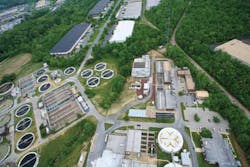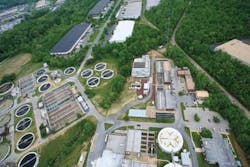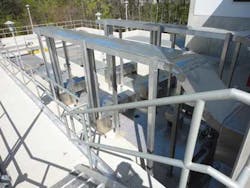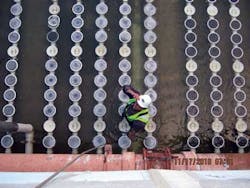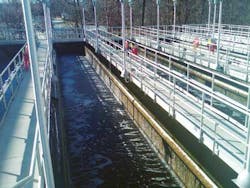A$92-million expansion completed in 2012 at the Little Patuxent Water Reclamation Plant (LPWRP) in Savage, Md., presents a model integration of bellwether aeration, disinfection and enhanced nutrient removal (ENR) systems added in tandem with other infrastructure upgrades that have significantly improved the plant's effluent and reduced harmful nutrients from reaching the Chesapeake Bay. The upgrades enable the plant to meet the goals set by the Third Chesapeake Bay Agreement (2000) and enactment of the EPA's Stage 2 Disinfectants and Disinfection Byproducts Rule (DBP rule). The plant operates at a permit rating of 25 mgd.
Formally designated "Addition No. 7," the LPWRP project required more than five years to design and complete for the Howard County, Maryland, Bureau of Utilities. The plant serves the heart of Howard County where 56 percent of the population resides.
To meet a compliance deadline and to instill more competitive pricing for the preferred type of denitrification system, suppliers were preselected on the basis of their technology's performance. The CMR-At-Risk contractor leading the design/build project delivery team worked closely with the owner's consultant in the procurements.1 The alternative approach saved the utility more than two million dollars and significantly compressed the schedule.
The multiple Xylem technologies selected for Addition No. 7 included: a 400-lamp WEDECO TAK 55 open channel ultraviolet (UV) disinfection system; nine Flygt brand mixers and a Flygt propeller pump; an additional 7,000 Sanitaire ceramic diffusers in the reactor aeration channels; and seven deep-bed, mono-media Xylem Leopold elimi-NITE® 2.0 ENR filters. The Leopold denitrification system can exceed the specified maximum reduction to 3.0 mg/L nitrogen and 0.3 mg/L phosphorus.
Other upgrades involved headworks screening, dewatering and clarification equipment, as well as replacing centrifugal blowers with a new, energy-saving turbo-type unit. Moreover, the existing biological nutrient removal (BNR) process was preserved and expanded with a new process reactor, secondary clarifier, launder covers on the secondary clarifiers, and a new solids processing centrifuge.
The collective improvements can achieve the equivalent daily reductions of 37,000 pounds of suspended solids, 4,730 pounds of nitrogen and 965 pounds of phosphorus and DBPs that would otherwise reach the Bay.
With a footprint of 64,229 square miles, the Chesapeake Bay ranks as the nation's largest estuary. The vitality and fishery have suffered the past 50 years as the region's growth increased byproduct nutrient loading, carried in with the effluent of wastewater treatment plants. Therefore, the impacts on the Bay have been both environmental and economic, which led to the multi-state voluntary agreements. A recently-signed Presidential Executive Order now calls for the federal government to assess every two years whether measurable environmental milestone improvements have been met by the Bay states.
Notes
1. The Calverton, Md., office of Atkins Global served as the owner's consultant with the CMR-At-Risk contract awarded to Clark/US, a joint venture between Clark Construction Group of Bethesda and the Ulliman Schutte Construction office in Rockville, Md.
Xylem Inc. is an exhibitor at the WEFTEC.13 event and can be found at Booth No. 1443.
